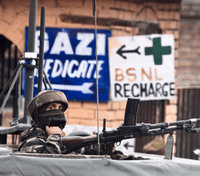The Kashmir conflict is a legacy of the post-colonial partition of the Indian subcontinent in 1947 into the Hindu-majority country of India and the Muslim state of Pakistan. From its genesis, the conflict has been defined by competition between India and Pakistan over the national identity of Kashmir's population. But the elites of both countries have also made the territory central to their respective principles of nation-statehood. In Pakistan's official ideology, Pakistan as a nation-state has been considered incomplete without Kashmir, a Muslim-majority territory contiguous to the Pakistani provinces of Punjab and the North-West Frontier Province. In the Indian counter-claim, the inclusion of this Muslim-majority territory in India has been considered vital to the validation of India's credentials as a tolerant state in which all faiths can coexist.
When independence from British colonial rule and partition came to the Indian subcontinent in 1947, Jammu and Kashmir (the full name of the territory disputed ever since) was among the largest and most populous of the subcontinent's roughly 562 "princely states." The Indian rulers of these princely states, which collectively covered about 45 percent of the subcontinent's land area, had previously accepted the "paramountcy" of British power in the subcontinent. Essentially, the principalities were governed by vassal potentates, while remaining indirectly controlled by the colonial power. At the time of independence, Jammu and Kashmir was governed by a Hindu kingship. However, Muslims comprised about 77 percent of its population.
Ever since, the dispute, rooted in competing ideologies of nation-statehood, has produced -- and been reinforced by -- recurrent armed conflicts over Kashmir between India and Pakistan. The newly independent nations fought a war in Jammu and Kashmir from October 1947 until January 1949. The end of hostilities saw the territory divided by a ceasefire line between a larger and more populous area under Indian control and a smaller and less populous area under Pakistani control. In 1965, hostilities flared again when the Pakistani military regime initiated a campaign designed to capture at least a part of the area under Indian control. On this occasion, the fighting spread from Jammu and Kashmir to flashpoints on the international border between the then-West Pakistan and India.

